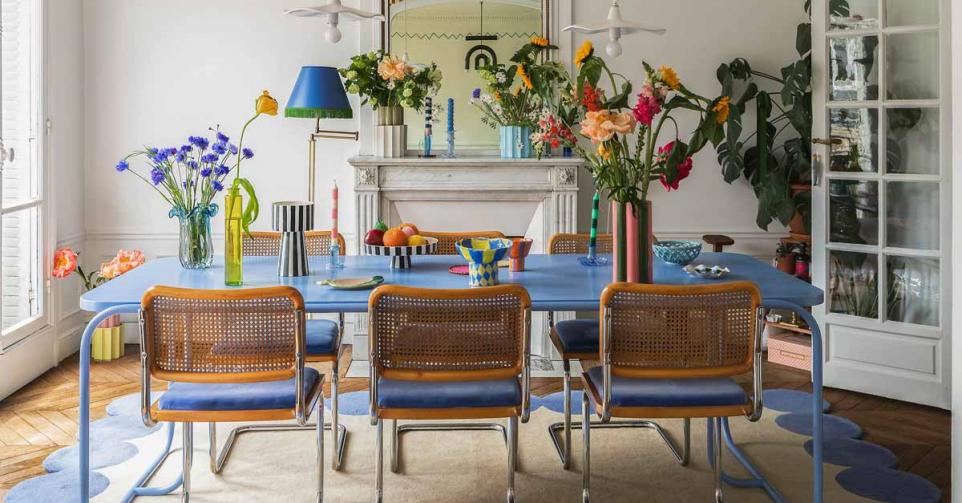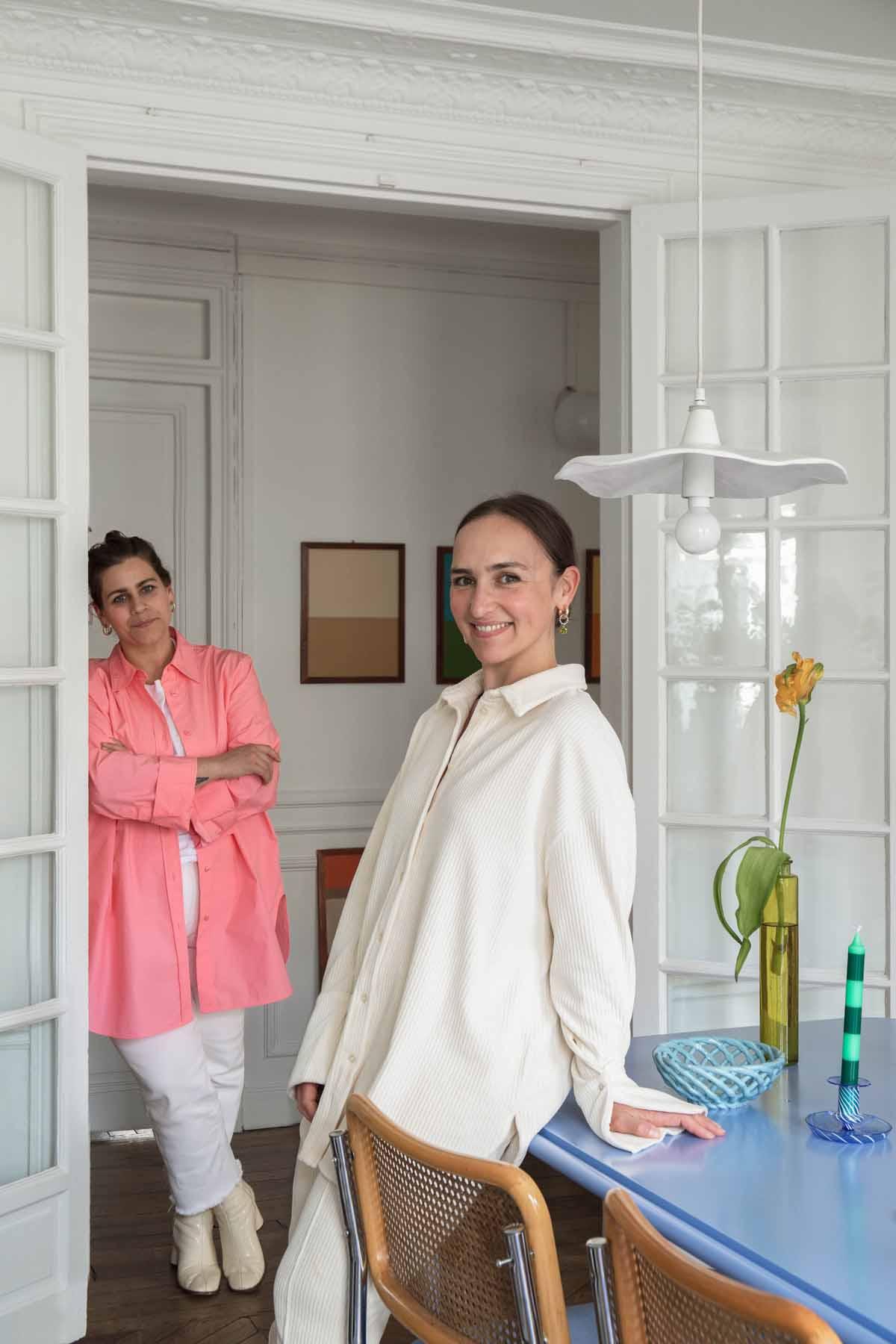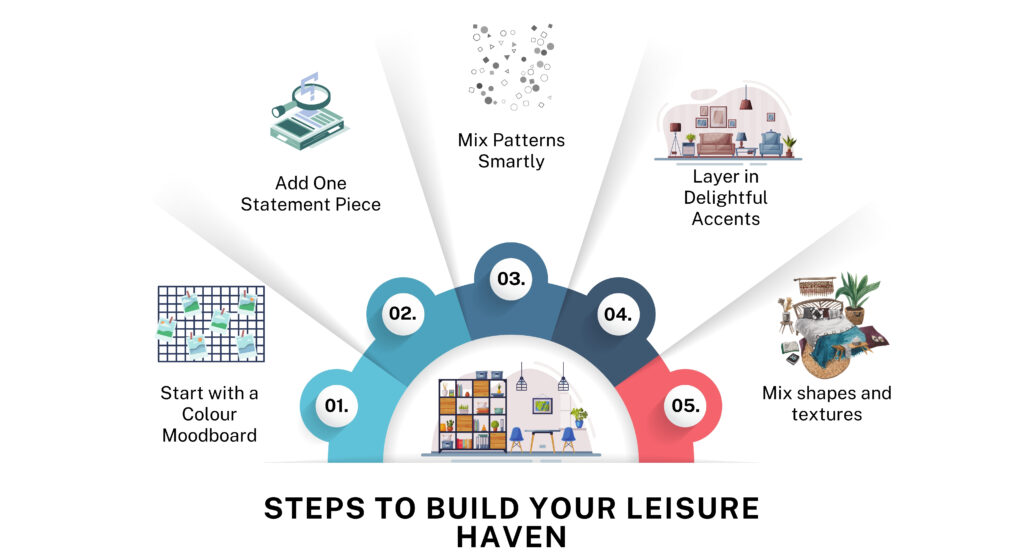Why Playful Interiors Matter
Playful interiors purposely deviate from minimalism in order to inspire delight, creativity, and emotional well-being. Design concepts like “dopamine decor” and whimsical aesthetics use brilliant colours, strong patterns, and joyful components to enhance moods and promote relaxation. According to research, leisure and play-oriented environments can improve social connection, reduce stress, and foster creative interaction. Whether you’re relaxing with family or hosting friends, lively interiors promote laughter and light-hearted moments.

Core Elements of Playful Design
Vibrant Colour Blocking
Large sweeps of vibrant colour are essential to playful design. Consider blocking a wall or ceiling in lively tones (fuchsia, mustard, turquoise) and matching them with complimentary accents. This approach generates dynamic visual energy, which instantly energises a room.

Whimsical Patterns & Quirky Accents
The use of unexpected fabrics, designs that do not match, and humorous motifs should be included. Certain rooms are adorned with charm and quirkiness via the employment of a variety of elements, like geometric rugs, colourful throw pillows, and humorous wall art.

Statement Furniture
Reading nooks with funny designs, chairs fashioned like slides, and modular seats are some examples of the types of furniture that are typically seen in playful places. Sculptural or toy-like furnishings are also common in these locations. These pieces are a joy to users and challenge established norms.

Biophilic & Playful Hybrid
Colourful pots, imitation vine garlands, and natural light fixtures are all great ways to bring together the elements of nature and play. These biophilic traits contribute to a sense of calm while maintaining a pleasant experience.

Inspirational Case Studies:
Anna Spiro’s Layered Whimsy
Designer Anna Spiro creates a fusion of contemporary art and antiques, including vibrant colour combinations. Through the use of eye-catching patterns and unexpected textures, she creates homes that are not only fun but also well managed.

Hawthorne River Front House by Anna Spiro Design (Gonzalez, 2019)
Parisian Rented Flat
Anaïs Seguin and Alice Gras transformed their Haussmann flat into a fanciful canvas that is both joyful and renter-friendly. They accomplished this by using removable panels, citrus-velvet couch modules, and geometric flooring.


Anaïs Seguin and Alice Gras(Feeling Redactie, 2023)
Coastal Cottage in Salcombe
A Victorian coastal home that is perfect for family leisure was revitalised by Sarah Southwell via the use of colourful, long-lasting finishes, a variety of room themes, and engaging hues that are safe for both children and dogs.

5 Steps to Build Your Leisure Haven
- Start with a Colour Moodboard
Pick one or two striking base colours. Play around with the ceiling, walls, and furniture. To test combinations, use online palettes like Canva or Pinterest
- Add One Statement Piece
Choose a unique piece, such as a carved coffee table, abstract sofa, or mushroom-style lamp. Allow it to establish the light-hearted tone.
- Mix Patterns Smartly
Combine solids with prints that are striking. To prevent overload, use patterned walls, rugs, or throw pillows and anchor them with a neutral background.
- Layer in Delightful Accents
Consider whimsical artwork, shaped mirrors, unique sculptures, or oddball clocks. Charm and conversation are fuelled by these character pieces.
- Mix Shapes & textures
Incorporate flora into your space by using organic-shaped furniture or lighting that is quirky. It is possible to promote relaxation by combining elements of nature with whimsy.

Maintaining Balance & Practicality
Keep Structure Neutral
The walls and the primary pieces of furniture in the space should be painted in hues that are either neutral or modest. When it comes to accessories, some examples of things that are deemed to be whimsical are lamps, cushions, and artwork.
Test with Temporary Installations
Utilise wallpaper that can be removed, furniture that can be rented, or modular carpets. Take into consideration how you are feeling before you commit to something.
Consider Function
Make certain that the parts that are intended to be playful are also enjoyable and safe for everyday usage, with robust materials and simple cleaning.
Rotate Items Seasonally:
Change the hues and accent pieces in a space on a quarterly basis in order to give it a new lease on life.
Final Thoughts
Playful homes celebrate colour, whimsy, and relaxation. They act on an emotional level; arousing our playful side and making environments feel alive. Whether through dopamine decor, nostalgic childhood themes, or hybrid designs that include nature, fun interiors transform everyday life into a pleasant experience. By carefully combining colour, form, and function, you can create leisure-focused environments that please both residents and guests, embracing both elegance and a sense of wonder. Allow your home to be a playground, and let design serve as an encouragement to relax, smile, and live more cheerfully.
for further details you can visit :
you can visit our website:
you can also search here:






